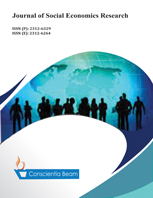Health Care Outcomes, Malnutrition and Food Security in Southern Africa Development Community: A Quantile Regression Approach
DOI:
https://doi.org/10.18488/journal.35.2019.61.1.12Abstract
The study analyzed the linkages among food security, nutrition and health care outcomes within the SADC regional bloc for the period 1991 to 2016. The study employed panel OLS and quantile regression analysis and the latter provided more informative findings that would culminate in the development of effective policies to deal with problems of infant mortality. Specifically, the study showed that population growth and malnutrition have a positive and significant effect on infant mortality across the entire distribution. The effect of investment in fixed capital and economic development is significant at higher quantiles. There is a non-linear relationship between infant mortality and population growth. Food security has no effect on infant mortality rate across the entire distribution and these results are consistent with those found using panel OLS. Robust results using quantile regression show that the sensitivity of infant mortality to each variable remains the same, statistically, but the magnitude or effect increases in higher quantiles. The study showed potential parameter heterogeneity across countries with implications for estimating the wider effects of mortality for a policy shock that may have unequal effects across the distribution. Properly developed policies should have a differentiated approach in influencing the rate of infant mortality in member states.

